skip to main |
skip to sidebar
Events of Wednesday, 27th April, 2016
Following breakfast, the guests readied themselves for a landing by dinghy on Oh Way Island for more swimming and snorkelling. As we approached the island, we passed close to a motor boat towing three or four dugout canoes. The motor boat had a wooden, framed hull and the usual long-tail arrangement driving a 2-blade propellor.

Passing local fishermen on our way from 'Meta IV' (moored in the
background) to the beach on Oh Way Island.
I'm confused as to the total number of canoes as they appeared to be at the point of 'parting the tow' so that the dugouts could operate independently but nobody seemed very interested in actually doing anything and the boats were slowly drifting into a tangle in front of us. I clearly hadn't quite adjusted to the slower pace of life in this area. I knew from earlier observations that, when action to manoeuvre the dugouts became essential, this would be achieved by rowing whilst standing, using the T-handled oars 'crossed', left hand working the right oar and right hand the left one.

Detail of the dugout canoes, showing how the T-handled oars are tied to the posts serving as 'rowlocks'.
We left the local 'fishing fleet' to disentangle itself and they passed out of view as we rounded a small, rocky headland to make our landing. Each beach we visited seemed to be trying to exceed the tranquility and pristine beauty of the previous one.
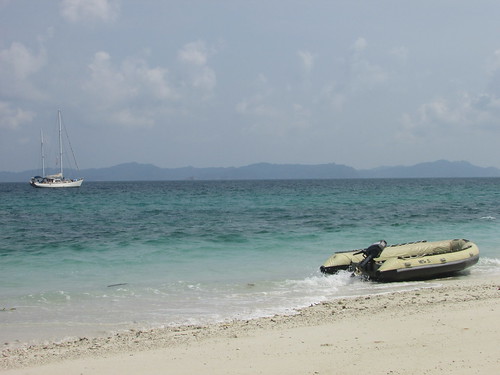
The shore at Oh Way Island with 'Meta IV' at anchor and our dinghy beached.
In an attempt to emulate the local 'pace', I neither swam, went beachcombing nor took photographs but 'enjoyed the moment', merely managing a couple of pictures of flotsam. In addition to the usual broken coral and pieces of wood, there was a well-preserved fishing 'creel' and, disappointingly, lumps of expanded polystyrene and a plastic bottle.

Beach visit: Flotsam.
I'm not sure how long we were on the island before Aung announced that it was time to return to our yacht for lunch. It's amazing how doing nothing stimulates the appetite. Our exploration of Lampi Marine National Park had come to an end. In the afternoon, we sailed back to where we'd spent our first night at sea, Ba Wel Island.
The crew 'set sail', literally, and to the accompaniment of only slight splashing noises from the sea against the hull and occasional flapping sounds from the sails as the wind altered, we made out majestic progress back to Ba Wel Island.

Under sail back to Ba Wel Island
The guests spent the next few hours mainly relaxing on deck whilst the captain and crew took turns at the helm.

Under sail back to Ba Wel with our Thai lady cook at the helm.
From time to time we passed fishing vessels of the types with which we'd become familiar - smaller wooden craft with 'long-tail' propulsion, larger vessels with inboard engines similar to the one we'd visited earlier in the trip (see The Mergui Archipelago (day 3)) and, finally, squid fishers with ungainly-looking booms deployed sideways, supported by a complex array of ropes.

One of the smaller fishing vessels we passed as we were under sail back to Ba Wel Island.
We anchored off Ba Wel Island in early evening as other fishing vessels returned for the night, clustering around us in a number of friendly groups.

Fishing boats clustered in an overnight group at Ba Wel.
The dinghy took us ashore for what was our very last beach visit. Although the landing beach was deserted, a child's swing, comprising two ropes suspending a wooden seat from the branch of a tree, suggested that children came here to play. Having tested the soundness of the construction (I wouldn't have wanted to damage their play equipment or myself), I couldn't resist trying it out, to the amusement of my fellow guests. A short walk led us to a second beach, with views in a different direction. Here, there was a broad, white sand beach, shelving very gently into a flat, calm sea.

Return to Ba Wel: A gently-shelving white beach and a flat-calm sea.
Since this was my last opportunity, I had a very gentle swim in the wonderfully warm water. As I emerged from the sea, I noticed that, further out, a number of squid fishing boats appeared to be preparing for a night fishing. As I walked back up the beach, I was attracted by the leaf-pattern formed by sand excavated by an unseen sand-dweller.

Return to Ba Wel: The leaf-pattern of sand excavated by an unseen sand-dweller.
As usual, I couldn't resist an attempt at an 'arty' shot of the sunset.

Sunset on Ba Wel Island.
As one of the last 'day' fishing vessels returned for the night, there was just time for a last picture of 'Meta IV' at anchor in the sheltered bay before boarding the dinghy for the short trip back to 'Meta IV', our final dinner and our final night aboard.
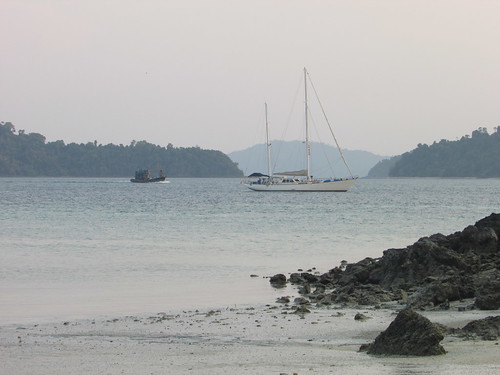
Return to Ba Wel: 'Meta IV' at anchor.
After it was fully dark, I was fascinated by a line of eerie green/blue lights stretching across our horizon. Of course, this was the fleet of squid fishing boats I'd noticed earlier. I was quite content to leave them to fish whilst I slept.

Return to Ba Wel: The eerie green/blue lights of a number of squid fishing boats working at night.
Related posts
Next post in this series.
All my posts on my trip to Myanmar in 2016 can be found here.
My pictures
If necessary, pictures in this article can be viewed uncropped by clicking on the image. To view in other resolutions or download, select from the albums below:-
Beach visit (60) and local fishermen.
Under sail back to Ba Wel.
Return to Ba Wel Island.
The Brewood Village Garden Party was held on Saturday, 16th July 2016. Once again, the venue was the garden at Brewood Hall.
Preparations
Although the Garden Party was open for just four hours, preparations started many weeks before. A number of planning meetings were held at Brewood Hall, deciding exactly what attractions would be offered and allocating the various tasks to volunteers on the organising committee.

Part of the organising committee pictured at a planning meeting
(L-R: Andrea, Becky, Marion, Marilyn).
In advance of the event, advertising 'flyers' were distributed around the village and various posters displayed, including one on the wall of Brewood Hall. Repairs were also carried out on the garden paths at Brewood Hall.
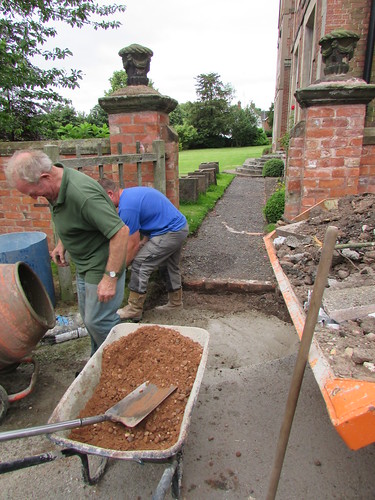
Path repairs at Brewood Hall.
On the afternoon prior to the Garden Party, the tents, marquees, tables, chairs and all the paraphernalia required were transported to Brewood Hall, involving a number of journeys by the organisers involving cars and trailers. In the evening, a team of Scouts appeared and, directed by the Scout Leaders, the piles of equipment were erected, producing a large double tent for refreshments, a large single tent for the musicians, two futuristic-looking Coleman Event Event Shelters and the large, traditional canvas marquee. Then, all the tables, chairs and other equipment was temporarily stored in the various tents, in case of overnight rain. It was fairly late when all this work was successfully completed.

Setting up the Brewood Garden Party 2016.

Setting up the Brewood Garden Party 2016: Assembling the large Coleman Event Shelter with the completed refreshment tent in the background.

Erecting the large marquee.
The Scouts returned on Saturday morning to complete the setting-up. Fortunately, it had remained dry overnight. Volunteers from the Church arranged a major houseplant and produce stall. Donations for this had started to arrive on Friday afternoon and more arrived on Saturday morning. The refreshment tent required a major effort to prepare and lay out the food, set up the tables and chairs both inside and outside the tent and provide floral displays of real flowers on each table. Electrics were laid on for water heating and for the Public Address system. An elaborate tent clad in netting was assembled to house the Catapult Range in complete safety. Other games were also set-up. Various other tables, tents or gazebo were erected for the Pimm's stall, raffle, tombola and the Staffordshire Corps of Drums. Volunteers from Brewood Scout's own shop 'The Trading Post' brought some of their stock to set up a stall at the garden party and the large marquee housed a number of craft stalls. Later, the Friends of Cannock Performing Arts Centre manned their Sales Stand. After a lot of hard work by the volunteers, all was ready for the opening, advertised for noon.
I've outlined this "behind the scenes" effort to illustrate the commitment of the volunteers to ensure a good experience for all the guests.
The Garden Party
Admission was via the double entrance gates in Sparrows End Lane which were specially opened for the event. A few minutes before twelve, the first visitors started to arrive and after a while the garden was thronged with people discovering the wide selection of attractions.

Brewood Garden Party 2016: The Admission table.
The mild weather encouraged visitors to wander from stall to stall or sit at one of the refreshment area tables to enjoy a hot dog, a cream tea or a Pimm's.

Brewood Garden Party 2016: The Refreshment Area.

Brewood Garden Party 2016: Houseplant and Produce and Raffle Stalls.

Brewood Garden Party 2016: Raffle Prizes.

Staffordshire Corps of Drums.
One of the innovations in 2016 was the Catapult Range.

Queuing for the Catapult Range.
Once again, the accomplished musicians from the Cannock Performing Arts Centre entertained the guests, with performances by both the Wind Band and the Big Band.

Brewood Garden Party 2016: Two bands from the Cannock Performing Arts Centre entertained the visitors.
For the first time, Banjo the Donkey and his owner offered rides in a modern, two-wheel donkey cart.
 Brewood Garden Party 2016: 'Banjo' the donkey.
Brewood Garden Party 2016: 'Banjo' the donkey.
At the end of the event, Ian Morris made a presentation of flowers and chocolates to Jan Ford and announced that proceeds would be divided between Brewood Scouts, the Church and the Jan Ford Foundation. There was then an 'official photograph' of representatives from Brewood Hall, Brewood Scouts and the Church.
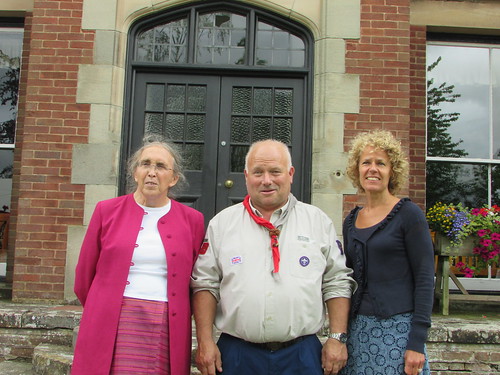
Brewood Garden Party 2016: Jan, Ian and Jane.
I am happy to report that all the visitors I have spoken to, both during the afternoon and subsequently, have confirmed that they enjoyed the event.
Reports on earlier garden parties at Brewood Hall
Brewood Vintage Garden Party 2013.
Brewood Vintage Garden Party 2014.
Brewood Garden Party 2015.
More information on the charitable work supported by the Jan Ford Foundation in Myanmar (formerly Burma) can be found by following the links below:-
Education Support
Medical Support.
Pictures of the event
Brewood Garden Party 2016.
Events of Tuesday, 26th April, 2016
Once again, we enjoyed a very adequate and varied breakfast in the dining area towards the rear of the open deck. I'm afraid we made some good-natured fun of the captain and crew reminding them that it was our fourth day on a sailing yacht and we hadn't yet seen a sail unfurled. They explained that the morning's itinerary was a journey of a few hours to Kyunn Philar East to replenish our fresh water tanks and they set about raising sail for the cruise. There wasn't a lot of space on deck for handling the ropes and windlasses which control the sails and the inexpert help of the guests was not required, so we watched with interest whilst keeping out of the way.
I mentioned in an earlier post that 'Meta IV', though originally having a ketch rig, had been simplified to a 'Bermuda-rigged Sloop' with simply a headsail and main sail, both supported by the mainmast. The 'mizzenmast' originally used by the ketch rig, whilst still present, carries no sail.

Under sail to Kyunn Philar: L: Headsail R: Mainsail. Note 'Guest flags', celebrating the countries of origin of the Guests.
When not in use, the triangular mainsail is stowed horizonally, folded into a canvas 'pouch' carried by the horizontal boom to which the bottom edge of the mainsail is secured. A headrope attached to the top corner of the mainsail is carried over a pulley at the top of the mainmast and led down to deck level where a winch or windlass near the cockpit is used to manage the raising and lowering.
The headsail, also triangular, is managed by a furler mechanism. The 'forestay' (which runs from the top of the mainmast to the bow) becomes a shaft which is rotated by ropes to unfurl or furl the headsail. When not in use, the headsail is thus tightly coiled around the forestay, ready for use. The control ropes are also taken to winches or windlasses near the cockpit. Bringing the winches and windlasses near the cockpit makes sail management easier with a small crew.
Most of the windlasses on 'Meta IV' are from Maxwell Marine. Headquartered in Auckland, New Zealand the company produces a wide range of winches/windlasses/capstans and associated equipment for boats.

Windlasses by Maxwell Marine on the starboard side of 'Meta IV'.
The headsail furler on 'Meta IV' is from Harken Inc. who are based in Pewaukee, Wisconsin. Their product range includes headsail and mainsail handling equipment, winches, pulley blocks and related accessories.

Lower end of Harken Headsail Furler on 'Meta IV'. Note the coloured scarves attached to the bow.
Once the sails had caught the wind, the diesel engine was shut down and we continued at around 8 knots. As we made our silent but majestic progress toward Kyunn Philar East, we passed a group of squid-fishing vessels. Although the basic boat design was similar to large, wooden fishing vessels we'd already seen when squid fishing is in progress, with massive, elaborately-guyed horizontal booms extended on both sides, and a complex system of ropes and pulleys for handling the lures, the vessels acquire a very weird appearance. I hope to write more about this interesting industry later.

Squid fishing vessel.
After around three hours cruising, we approached Kyunn Philar East so the foresail was furled, the mainsail was lowered and our diesel engine was restarted as we manoeuvred towards land. Three fishing boats were anchored together in the bay. Steel hulled, fairly large, they appeared rather more modern than other vessels we'd seen and the wheelhouse was perched on top of the superstructure with all-round windows. A massive net was piled high on the foredeck together with a novel design of derrick presumably for handling the net. Three crew members on the nearest boat viewed the visitors with interest.
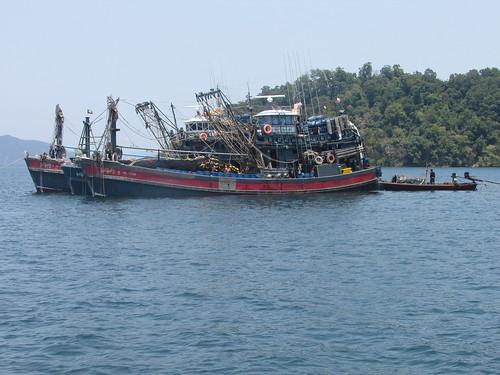
Fishing Boats anchored at Kyunn Philar.
A low, wooded hill led down to the water's edge. There were few buildings visible but one narrow patch of hillside had been largely cleared of trees and a flight of concrete steps led straight up from the shore to the top of the hill where a golden pagoda stood on a concrete platform supported by concrete piles.

Kyunn Philar Pagoda.
Looking to the right, there was activity about 100 yards off the beach where three smaller fishing boats clustered around a rectangular, moored raft which carried a building with a corrugated iron roof and woven bamboo sides.
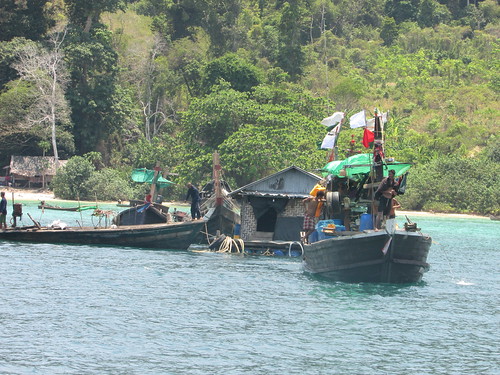
Kyunn Philar East, Mergui Archipelago: The floating Water Station.
Seeing a number of plastic hoses dangling from the raft, I concluded that this was where we would replenish our water tanks. I assumed that a pipeline ran down the hillside and extended across the sea bed to the raft. There was no sound of a pump on the raft, suggesting that, having dammed a suitable perennial stream, the hose permanently discharged freshwater into the sea. As we slowly approached the raft, the three fishing vessels moved away and 'Meta IV' attempted to throw a mooring line to a man on the raft.

The Water Station raft. One line is already attached to the raft on the right and a second has been thrown.
It took a few minutes to secure two lines to the raft and receive the end of one of the plastic hoses. Set in our deck on the port side was the filler for the one freshwater tank. With the metal cap unscrewed, the end of the hose was inserted and the watering process started.

The Captain filling the port fresh water tank.
When the port tank was full, the hose was transferred to a similar filler on the starboard side deck to fill the other tank.
The sea around the raft was teeming with fish in a circling frenzy, presumably after food.

Fish in a frenzy by the water station raft.
On completion of taking on water, we manoeuvred away from the raft using the engine and then went back to 'sail power'.

Sail power: Unfurling the headsail.
With the Captain at the helm, we sailed around Kyunn Philar Island towards the west side, passing various fishing boats on the way.

The Captain at the helm of 'Meta IV' under sail.
We anchored off a beach with coral reefs and transferred to the dinghy which took us nearer to the shore allowing my fellow guests to take to the water for snorkelling. I stayed in the dinghy, quite happy in the peacefulness of the spot. Even when Aung, who was the 'boat driver', donned snorkel gear, left the boat and swam to make sure that all the snorkellers were safe, I was quite content to be adrift, alone in the dinghy. Aung returned and we landed on the beach, ready to take the guests back to 'Meta IV'.

Kyunn Philar: We spent the afternoon in this tranquil bay.
I had neither the inclination to swim nor explore very far: I was content to sit in the sun and enjoy the moment. As dusk approached, Aung summoned the snokellers and returned us to our ship in the dinghy.
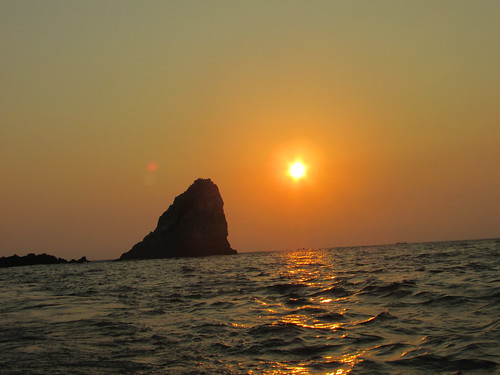
As dusk approached, we returned to 'Meta IV' in the dinghy.
As usual, dinner was the main event of the evening, after which I was ready to retire for the night.
Related posts
You can read about the following day aboard 'Meta IV' here.
All my posts on my trip to Myanmar in 2016 can be found here.
My pictures
If necessary, pictures in this article can be viewed uncropped by clicking on the image. To view in other resolutions or download, select from the albums below:-
Sailing Vessel 'Meta IV'.
Under sail to Kyunn Philar.
Kyunn Philar East, Mergui Archipelago.
Sail power.
Viewing coral and on the beach.
In the post Myanmar, Serendipity and Jan I talked about how Myanmar became important to me and listed the aims I have during my visits as follows:-
1. To see more of the country and learn more about its people.
2. To visit educational initiatives supported by the 'RTM Social Contribution' charity.
3. To visit the Bagan Medical Clinic supported by the 'RTM Social Contribution' charity.
4. To study Myanmar's railway system. (Huh?)
Let me explain the last of these aims.
Anybody browsing my website quickly becomes aware of my interest in railways. As far back as I can remember, I was interested in railways and engineering. That probably partly derives from my grandfather, who was an engineer and liked nothing better than explaining how things worked with an enthusiasm which was infectious.
My interest in railways was fairly general until I had a few opportunities to visit signal boxes which kindled a more serious study of railway signalling. This period is described in the post Visiting Signalboxes which includes links to posts describing specific English signal boxes.

Exeter West signal box, now preserved at Crewe Heritage Centre.
Modernisation of British Railways first produced an interesting but short-lived series of modern steam locomotives before the widespread introduction of main line diesel and electric traction. In addition, Power Signal Boxes and Colour Light Signalling abolished many of the traditional manual signal boxes and semaphore signals which had fascinated me. These changes are briefly outlined in the post The Modernisation of British Railways.
The withdrawal of steam and the destruction of manual signal boxes 'broke my heart' and I turned my back on railways, still travelling by rail but the railway was no longer as I remembered it and something of the spirit which had excited me had been lost. However, after I started a small business, we started to provide telecommunications equipment for the railways, first in Britain and later overseas. This period is described here so that re-kindled my interest.
However, it was not until I was in my 40s that I became actively involved in railway preservation and took a more serious interest in railway locomotives, as I explain in the post Lion. As a result, many of the posts in this blog describe aspects of railway preservation, railway history and modern railways both in this country and abroad. These posts can be found under the label Railways. Railway signalling remains a particular interest - signalling posts can be found here (although they're also included in the Railways label).
On my first visit to Myanmar in 2008, an unexpected rush of a sense of adventure induced me to take a journey unaccompanied on the 'Circle Line' in Yangon (this trip is described here). This was probably on the basis of "I may not pass this way again", but I underestimated the fascination of Myanmar and its people - I've recently completed my 10th trip to the country! In three hours, I learned more about the life of people in Yangon and accumulated more technical questions about the railway system than I could reasonably have anticipated. I'm still trying to learn about the people of Myanmar and still trying to answer those railway questions. In Myanmar, there always seem to be more questions than answers.

Kyee Myin Daing South signal cabin, still in service in 2016.
Whereas there is a plethora of information on railways in Britain and a fair bit on other world railways, I could find little on Burma (with isolated exceptions). My friend Dieter's book 'Railways of Myanmar' is now nearing publication and is anxiously awaited.
I realised that modernisation of the railways in Myanmar had only recently started to gather pace, giving me an opportunity to try to document some aspects of the 'traditional' railway before it is swept away. My investigations are patchy because of limited opportunity and my observations even more likely to be flawed than normal but I intend to continue to do what I can to record this fascinating, British-inspired, railway system.
On Sunday 22nd May 2016, the 'Peak Forester' Railtour, operated by the Railway Touring Company, ran from London to Rowsley, the northern terminus of Peak Rail. The train was hauled by Bullied Light Pacific 34052 'Lord Dowding'. Actually, this locomotive was really 'West Country' class 34046 'Braunton' but re-numbered and re-named to commemorate the 75th anniversary of the 'Battle of Britain' since the original locomotive 34052 was scrapped at Barry. 34046 was restored by Locomotive 34046 Limited and is currently based at Locomotive Services Limited, Southall.
On previous railtours I've seen at Peak Rail (see 'Related posts' below), the Peak Rail 'top-and-tailed' service train has continued running all day, requiring this train to 'recess' in the Up Loop at Darley Dale whilst the rail tour arrived and then 'recess' in the Down Loop at Darley Dale when the railtour departed. More problematically, on arrival at Rowsley and having discharged its passengers, the stock of the railtour had to be shunted across to the loop so that the platform line was available for the 'top-and-tailed' Peak Rail service train to arrive and deport.
So, for the 2016 'Peak Forester' it had been decided that the 'top-and-tailed' Peak Rail service train would only operate three round trips (rather than the normal five) and that the 6-coach Peak Rail train would then be stabled in the yard at Rowsley, leaving the platform line and run round clear for the arrival, servicing and departure of the railtour.
I was rostered on 'Lord Phil' with Phil M. We operated the scheduled three round trips top-and-tailing with D9539 (Class 14) before assisting the diesel in stabling our train in the Heritage Shunters yard and disposing of our locomotive on the outside pit. We then moved forward to stable outside the shed, leaving plenty of room for the visiting locomotive to use the pit.

'Lord Phil' was stabled clear of the outside pit.
Although I've been rostered at Peak Rail on the dates of a number of previous Main Line Railtours, this was the first time I've been at Rowsley and able to watch the activities there. Quite a few spectators had gathered at Rowsley by the time we had the 'wire' that the Railtour was 'on time' joining Peak Rail metals.

Some of the spectators awaiting the arrival of the steam special.
Two lorries had arrived - a self-unloading Mercedes 8-wheel coal lorry with fuel for the return journey and an articulated tanker with water. I made my way back to Rowsley's single platform to watch the Railtour come to a stand very gently.

'Lord Dowding' arriving at Rowsley.
It had been some years since I'd been in charge of a Bulleid locomotive. I became familiar with 'Merchant Navy' class 'Canadian Pacific' at Birmingham Railway Museum, when she was used on 'Learn to be a Driver' courses. On completion of that duty, the locomotive spent a weekend as a static exhibit at a major exhibition at the National Exhibition Centre. Queues of visitors formed for the opportunity of standing on the footplate whilst museum staff gave explanations. I wasn't rostered for duty at the exhibition but, when I turned up as a visitor, I was invited to act as relief by the harrassed crew which I did, wearing a blue polka-dot summer dress and high heeled shoes! Later, I worked on 'West Country' class 'Taw Valley' both when she had a spell on 'Learn to be a Driver' courses at Birmingham Railway Museum and also at the Battlefield Line on both 'Learn to be a Driver' courses hauling a private passenger train along the full length of the line and on Service Trains. I really must try to write more about Bulleid's remarkable 'Pacifics'.
As soon as the train stopped, a number of people descended from the footplate (including Roger Hallett, who'd acted as the Peak Rail Conductor Driver) and a crowd of support crew appeared from the Support Coach marshalled as the first vehicle in the train. The locomotive was uncoupled from its train and drawn forward level with the water crane. Surrounded by support crew, the locomotive was watered both from the Peak Rail water crane and the road tanker, whilst a succession of fire irons was used to break up the firebed ready for dropping the fire.

34052 taking water.
The locomotive then shunted across to the 60-foot vacuum-operated turntable to be turned for the return journey. The inauguration of this turntable in 2010 (described in the post In a Spin with Pete Waterman) allowed Peak Rail to welcome steam Railtours. Now facing London, the locomotive moved gently to the outside pit to drop the fire. This was originally called the 'Turnback Pit' as it was intended for visiting engines arriving with a train and requiring fire-cleaning, coal, water and perhaps oiling before departing with another train, so the use 34052 made of it was historically correct. The Palfinger hydraulic grab crane on the coal lorry transferred its load to the Bullied tender whilst a new fire was laid in the firebox and ash was cleared from the sides of the wide firebox.

Coaling and ash clearance on the Turnback Pit.
Meanwhile, Rowsley's 'Class 31' had shunted across to the coaching stock, detached the support coach, run round to the other end of the support coach (using the 'short loop' formed by the main run round loop and the connections on the 'Third Line' by the Loading Dock) and re-attached the support coach to the London end of the train, ready for 34052. I presume the 'Class 31' was used as it was dual-fitted with both vacuum and air brake systems and it was desired to shunt the Support Coach using the air brake system.
All that now remained was for the 'refreshed' 34052 to shunt from the 'Turnback Pit' back to its train, ready for the marathon journey back to London. Well, I'd had a fairly early start, so I was content to say my 'goodbyes' at that point.

34052 on the run-round loop at Rowsley, heading back to its train.
Related posts
Reports on other main line rail tours I've seen at Peak Rail are listed below:-
2015: The Dimple, Darley and Dale.
2014: HST Charter to Peak Rail.
2013: The 'Peak Forester'.
2012: Steam Charter to Peak Rail.
All my posts on Peak Rail can be found here.
My pictures
Pictures in this article can be viewed uncropped by clicking on the image. To view in other resolutions or download select from the album below:-
'Peak Forester' 2016
All my pictures at Peak Rail can be found here.
The first tram system in Rangoon
Steam trams were introduced in Rangoon (as the British called Yangon) towards the end of the 19th century, without conspicuous success. The system was electrified in the early 20th century and, by the mid 1930s, was carrying 40 million passengers a year.

Shwedagon tram terminus in the 20th century (Photo: Tram Views of Asia).
Bombing of power stations by both the British and the Japanese during World War II led to power shortages which sealed the fate of the Rangoon Electric Tramway, although post-war wrangling over shareholder compensation meant that the company was not finally liquidated until 1961. There's a brief article on this period here.
The Building of Rangoon's Docks
The British developed extensive docks on the north shore of the Yangon River with extensive rail access from the British-built metre gauge railway system. Like Liverpool's docks, Rangoon's docks were enclosed and, just outside the enclosing walls of the docks, there is a dock access road which runs parallel to the important Strand Road built on the landward side. The dock access road was provided with a railway line with sidings into the docks at various points. At the western end of the docks, this line branched inland to reach interchange sidings with the main railway system at Kyee Myin Daing. At the eastern end of the docks, a second branch went inland to meet the main railway system at Pazundaung. Just north of Pazundaung, a large marshalling yard and motive power depot was built at Mahlwagon. There's a description of a visit to Mahlwagon area here.
The Rangoon Guide Map of 1930 (published under the direction of Brigadier R. H. Thomas D.S.O., Surveyor General of India) gives a good idea of the extent of the docks at that date and the elaborate network of railway sidings built to serve the docks.
 The central area of docks in 1930.
The central area of docks in 1930.
Click here for a larger view
Recent Developments in Yangon's Docks
Like Liverpool, Yangon's dock area has seen massive changes with the introduction of Containerisation, including the construction of a completely new deep-water port at Thilawa, 16 miles from Yangon (see website here). In 2014, exploring Strand Road, I was surprised to find that the railway line along the dock access road, inset in concrete, was now dual-gauge (metre/standard gauge).

Looking west along the Dock Access Road, Strand Road, Yangon in 2014, showing dual gauge (metre/standard gauge) track.
This discovery is described in the post here. I found the railway goods depot still in use at Botataung (on the landward side of the line) and, later, I confirmed that there's a second depot still operating at War Dan (on the river side of the line). Although I was now certain that metre gauge trains must still run along this dock line to service these depots, it was not until Tuesday 5th May 2015 that I actually saw an unidentified Bo-Bo-Bo diesel-electric slowly make its way westbound along the dock line with a short train of bogie vans as I took afternoon tea in the Cafe at the Strand Hotel at about half past five. The following morning, I had a greater surprise for, at twenty past seven whilst taking breakfast in the Cafe at the Strand Hotel, red-liveried railcar RBE 30.02 paused briefly opposite on its way east on the dock line.
Plans for Yangon's Electric Railway Revealed
Before I had an opportunity to investigate the standard gauge trackwork and whether there was now a passenger service along Strand Road, my railway friend in Myanmar informed me that Yangon was to open a new Electric railway and I found limited information on the internet.
A report on the MITV site dated 25th August 2015 (see [reference 1] below) stated that carriages of electric train (tram rail) which would be used for the first time in public transport of Myanmar had arrived at Thilawa Port, and would commence operation in October 2015. The project, led by Myanma Railways, was intended to provide better services and facilities for train commuters. U Ohn Kyi, Assistant General Manager, Myanma Railways (Lower Myanmar) claimed that 18 freight, 379 passenger and 25 Circular trains were currently operated but the electric train project would construct three new electrified lines, ultimately leading to an electric Circular train in addition to the current Circular Line services which transport around 100,000 people a day. U Kway Lwin, Assistant Engineer, Myanmar Railway (Urban), added that the new lines would be standard gauge.

One of the 'new' trams, numbered 3005B in 'salmon pink' livery (Photo: MITV).
The announcement was starting to make sense to me. I already knew that Myanma Railways 'RBE' single-unit diesel railcars were actually supplied second-hand from Japan (see report Diesel Railcars in Burma). In 2013, I first saw other second-hand diesel multiple units from Japan starting to appear and, on my most recent visit in 2016, I found that 5-car Diesel Multiple Units are now common around Yangon. This initiative is part of a comprehensive plan put forward by the Japan International Co-operation Agency (JICA), outlined in my post here. If diesel railcars and diesel multiple units can be given extended usefulness in this way, why not also re-cycle second-hand Japanese standard-gauge trams to Myanmar?
I found a couple more pictures from MITV showing a 3-section tram, apparently ready for service and also a piece by 'ElevenMyanmar' reporting a deal between Myanmar Government and the "Japanese West Corporation" signed 27th July 2015 which would start operating a service the same year along the Yangon Waterfront. The Ministry of Rail Transportation said the service would open from Pansodan to Htawlikwae in Ahlone Township in October and from Pansodan to Lansdown in December. The Japanese partner would provide the specialist equipment for overhead power distribution and the Yangon Electricity Corporation would provide the 5 megawatts power required. The electric power poles would be erected 50 metres apart. Two 3-section sets and one 1-car set would be prepared and would provide speeds between 19 and 25 miles per hour. I'm not sure about the "Japanese West Corporation" but this may refer to the public company JR-West which provides transport in Western Japan.

A '3-section' tram numbered TCE3001 in its rather fetching Myanma Railways livery of two-tone blue with grey undergear (Photo: MITV).

Detail of the pantographs on TCE3001 (Photo: MITV).
My railway friend confirmed my understanding, informing me that the vehicles were type 1650 trams, originally used in Osaka, Japan and that public operations would commence on 11th January 2016.
On 22nd December 2015, Myanmar Business Today (see [reference 2] below) confirmed a delay in starting the service giving a new start date of second week of January 2016, according to U Kyaw Soe Lwin, Deputy General Manager of Myanma Railways (MR). U Htun Aung Thin, General Manager of Myanma Railway (Lower Myanmar) commented that the electric train would be fully air conditioned and have three carriages. It would run ten times per day and tickets would cost 100 Kyat each (about 10 cents U.S.). U Tun Aung Thin said the electric trains were equipped with a capacitor bank, to prevent the train from stopping suddenly in the event of an electricity cut. I'm not sure that I understand this last remark unless it refers to Ultra-capacitors retro-fitted to 40 year old rolling stock, which seems unlikely.
On 11th January 2016, MITV reported an opening ceremony the previous day (see [reference 3] below) and Myanmar Times gave a very upbeat assessment of the future (see [reference 4] below). On the 12th January, the Railway Gazette (see [reference 5] below) had a brief report under the title 'Yangon launches light rail line' and, by the 19th January 2016, BBC Asia had posted a video under the title 'Trams return to the streets of Yangon' (see [reference 6] below).
Jan takes the tram
I travelled on the line on 21st April 2016 (producing a brief report here and pictures here. Operating over a line extending less than three miles, with a one-way journey time of 30 minutes and with a service frequency of just three return trips each day, the tram could hardly be expected to be a commercial success at this stage. However, I was quite favourably impressed. The 3-section tram I travelled on, whilst elderly, appeared quite well refurbished. The overhead power system, as far as I could judge, was of modern design and properly implemented.
Operations suspended
On 1st July 2016, another online media company, 'Yangon Coconuts', published the following obituary under the title 'No more electric tram on Yangon's Strand Road' (see [reference 7]):-
It was good while it lasted. Or maybe it wasn’t, since so few people bothered to buy a ticket. Yangon’s fancy new electric tram stopped service today after only six months of running along Strand Road from Linsadaung to Wardan Street. It was a short route of only a few miles but was supposed to help ease congestion on Strand Road. Trams ran along Strand Road in colonial times and the project, a $3 million deal between Myanma Railways and Japan's West Corporation, was aimed at reviving the alternative transportation as Yangon’s streets brim with taxis and buses. But it didn’t catch on. Myanmar Railways general manager Tun Aung Thin told Global New Light of Myanmar that a few days ago only 10 people took the tram, and without going into specifics, he said accidents would sometimes occur in crowded areas. He also told the Voice that, instead of relieving congestion, the tram sometimes added to it because of all the container trucks plying the route right next to the tracks running along Strand Road. The carriages will be kept near Wardan Street to use in special cases, such as if there are emergencies. Well, RIP Yangon’s electric tram. We'd like to say it was nice having you around, but you were here for such a short time we never got to know you.
Afterword
Although I'd been impressed by what had been achieved, there were clearly a number of constraints on successfully developing the tram system. The initial route was single-line with no passing loop. The route was shared with heavy vehicle traffic to and from the dock area, giving rise to access conflicts. Earlier announcements said that the initial route would be extended at the western end to Kyee Myin Daing and at the eastern end to Pazundaung. Certainly, I had seen dual gauge track on the dock branch at Kyee Myin Daing (see report in the section 'The Docks Branch' of the post Kyee Myin Daing) so at least some work was put in hand. In addition, Yangon's electricity cuts off quite frequently because of lack of capacity and the wisdom of using "the amount of electricity to run a small city ward" for a tram has been questioned.
At the opening ceremony, U Htun Aung Thin, General Manager of Myanma Railway (Lower Myanmar), was quoted as saying "We want to provide good public transportation. At present we will run three carriages that can carry nearly 460 commuters. Of all the types of train, the tram is the easiest to maintain and operates at a low cost. We will continue to offer this service whether we gain profit or not. By using this tram, commuters from six downtown townships will find their journey to work more convenient and they can avoid traffic jams.”
But, apparently, it was not to be. A Short History, certainly, but not a happy one.
Related posts on other sites
[reference 1] 'MITV' (Myanmar International Television).
[reference 2] 'Myanmar Business Today'.
[reference 3]'MITV'.
[reference 4] 'Myanmar Times'.
[reference 5] 'Railway Gazette'.
[reference 5] 'BBC Asia'.
[reference 7] 'Yangon Coconuts'.
Related posts on my site
see Trams Return to Rangoon
My pictures
Yangon's Trams.
(Pictures may be viewed and downloaded in various resolutions).























































